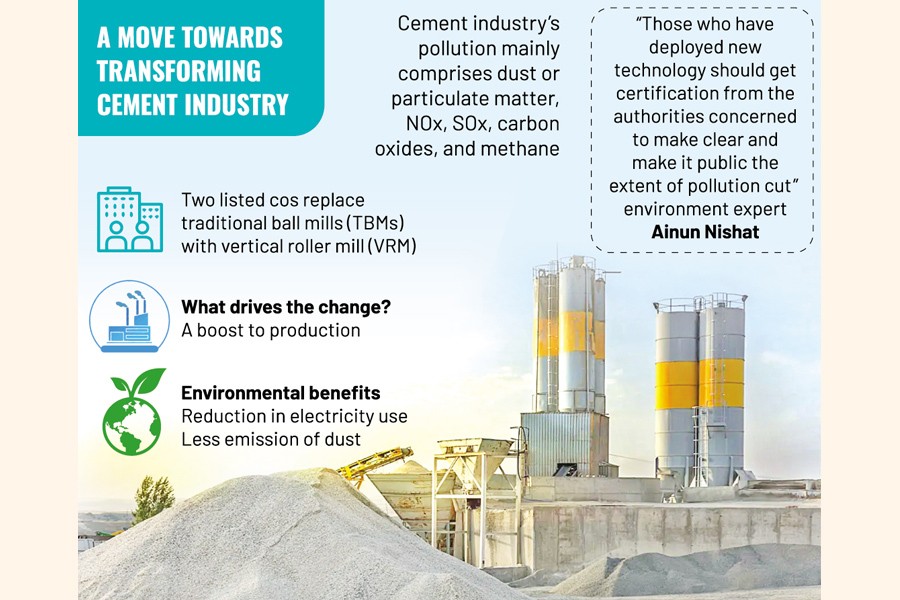
Two listed cement makers have been adopting technologies in moving towards high production at an expense of less energy and less emission of dust.
Though the primary motive in this is to scale up production, energy efficiency has encouraged Crown Cement and Premier Cement Mills to fully transform their manufacturing process.
Both the companies have been replacing traditional ball mills (TBMs) that they used to manufacture cement with vertical roller mills (VRMs).
Representatives from the cement makers said TBMs needed a larger space and manpower to run and around 20 per cent more electricity than VRMs to produce one metric tonnes of cement.
Apart from being energy efficient, a VRM emits one-tenth of the dust created by the age-old production process, they said.
Pollution by cement manufacturers is a world-wide concern. Bangladesh lacks data to paint a picture of industry-wise pollution but globally available data can help understand the depth of the problem.
For example, a single cluster of large-scale cement plants in a North Indian state is responsible for 5 per cent of the world's CO2 emissions caused by human activities, according to a report by India-based Devic Earth that promotes clean air technologies.
The cement industry's pollution mainly comprises dust or particulate matter, NOx, SOx, carbon oxides, and methane.
Bangladesh's cement makers are on the top of the manufacturers responsible for environmental pollution, said Professor Ainun Nishat, an expert of water resource management and climate change.
The companies, which produce clinker, main raw material for cement, which is a mix of limestone and minerals, are largely responsible for carbon emission.
"Those, who claim a lower level of pollution [in manufacturing cement] at eco-friendly plants, should be taking certification from the authorities concerned. Then the extent of pollution reduction will be clear to the public," Prof. Nishat added.
Crown Cement started installing a second VRM unit in June 2021 at an estimated cost of Tk 7.7 billion; the aim was to expand the production capacity to 19,280 metric tonnes per day from the existing capacity of 11,000 metric tonnes a day.
The chief adviser to the board of Crown Cement Group, Masud Khan said the board members had been inspired to install the second VRM unit following the successful operation of the first one.
"The second VRM unit is likely to begin production soon," he said.
A VRM is able to produce roughly 220 metric tonnes of cement per hour, as claimed by the companies, whereas a TBM produces only 30-40 metric tonnes per hour.
Crown Cement is installing the second VRM unit with bank financing.
Company secretary Md. Mozharul Islam said the bank had provided loans assessing the prospect of the project.
Increasing revenue and income is at the centre of the technological reform in the absence of any regulatory obligation on listed companies to cut damaging impacts on the environment. Neither has the securities regulator given any incentive to encourage such a transformative measure.
Mohammad Rezaul Karim, a spokesperson of the Bangladesh Securities and Exchange Commission (BSEC), said the corporate governance code had a provision of including an Environmental, Social, and Governance (ESG) report, if there was any, in the director's reports by the companies.
"The regulator encourages issuer companies to lay importance on environment-friendly production."
The encouragement is limited to lower consent fees in the issuance of green bonds. The consent fee is 0.1 per cent of the face value of a regular bond while the fee is 0.03 per cent of a green bond.
Meanwhile, Crown Cement bagged a net profit of Tk 610 million in FY23 against a loss of Tk 229 million in FY22, riding on a rise in sales and product price.
A decline in raw materials' prices in the international market also helped the company to recover from the loss.
Premier Cement Mills has five production units, including one VRM.
The company secretary, Kazi Md. Shafiqur Rahman said the cement maker need not to depend on four TBM units as the VRM is able to meet the production target.
"The TBM units are used only when the demand goes up."
A lower production cost coupled with a higher production volume will play a big role in boosting the company's profit in the days to come, added Mr Rahman.
Premier Cement endured a loss of Tk 842.2 million in FY23. The loss was even higher in FY22.
However, the company returned to profit during the July-September quarter of FY24. It earned Tk 56.94 million in the quarter against a loss of Tk 266.79 million during the same period of the previous year.
A total of 37 active cement factories in the country have an aggregate annual production capacity of 58 million tonnes, whereas the domestic demand is 35 million tonnes.
Apart from the two listed cement makers, some non-listed companies of the industry have also installed VRM units.
Manufacturers are largely blamed for polluting the environment through unplanned systems.
Now many enterprises are seen to be taking measures to address concerns to some extent over their carbon footprints, without compromising the monetary value generated by the businesses.
© 2024 - All Rights with The Financial Express
